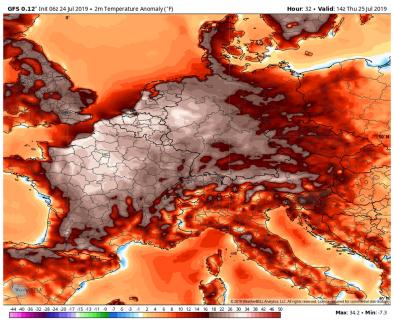July was Earth’s hottest month on record, beating or tying July 2016

July was Earth’s hottest month ever recorded, coming in slightly higher than the previous warmest month, which was July 2016, according to data from the Copernicus Climate Change Service. This European climate agency said in a statement Monday that July 2019 was 1.01 degrees (0.56 Celsius) above the 1981 to 2010 average, “which is close to 1.2 Celsius above the preindustrial level as defined by the Intergovernmental Panel on Climate Change (IPCC)," the agency said in a statement.
The month beat July 2016 by about 0.07 degrees (0.04 Celsius).
On Thursday, U.N. Secretary General António Guterres cited preliminary Copernicus data at a news conference as an example of why more ambitious action to cut planet-warming greenhouse gases is needed.
“We have always lived through hot summers. But this is not the summer of our youth. This is not your grandfather’s summer,” Guterres said as he called upon countries to rapidly cut their carbon emissions.
...
July’s numbers clearly indicate that the planet is already lapping up against the lower threshold. It also means the world is headed for a top 3 warmest year, up from a top-5 warmest ranking earlier in the year. The period from 2015 to 2019 will go down in history as the warmest five-year period on record since the late 19th century and, probably, well before that.
The temperature spike was driven largely by record warmth in Western Europe, noteworthy warmth stretching across the Arctic that culminated in one of the most significant melt events ever recorded in Greenland at the end of the month.
During the entire month of July, the Greenland ice sheet poured 197 billion tons of water into the North Atlantic in July alone, enough to raise global sea levels by 0.5 millimeters, or 0.02 inches.
...
Globally, Copernicus found that temperatures were well above average across Alaska, Baffin Island and Greenland, parts of Siberia, the central Asian Republics and Iran, as well as large parts of Antarctica. In addition, nearly the entire continents of Africa and Australia were warmer than average. Parts of western Canada and Asia saw cooler-than-average conditions.
...
Key caveats
Copernicus, a climate services program from the European Union, reports its monthly temperature rankings earlier than other temperature tracking agencies such as NASA, and its rankings may differ slightly. This is because it uses a different source for its data.
The ranking was generated using what are called reanalysis records, which take data collected for weather forecasting and feed many different observational variables into a weather model for each hour of every month.
Reanalysis data tends to allow for faster reporting of monthly global temperatures, but it still must be checked against observational records gathered from networks of thousands of measuring sites worldwide.
Those readings will be reported by NASA, NOAA and other agencies in the coming weeks, but they’re not likely to differ significantly from Copernicus. These agencies may, however, give the month a slightly different ranking.
The monthly temperature record comes without the added warming influence of a strong El Niño event in the tropical Pacific Ocean. Such events add heat to the oceans and atmosphere and help boost planetary temperatures. The 2016 record, for example, occurred during a year with a strong El Niño. The lack of a significant El Niño this July shows how much easier it is to set temperature records on a rapidly warming planet.
“The fact that summer 2019 is as warm (or warmer) than 2016 shows that in a few years the relentless march upward of temperatures driven by increasing atmospheric greenhouse gas concentrations can make what was an exceptionally warm El Niño event into a typical summer,” said Zeke Hausfather, a climate scientist with Berkeley Earth, via email.
Related Content



